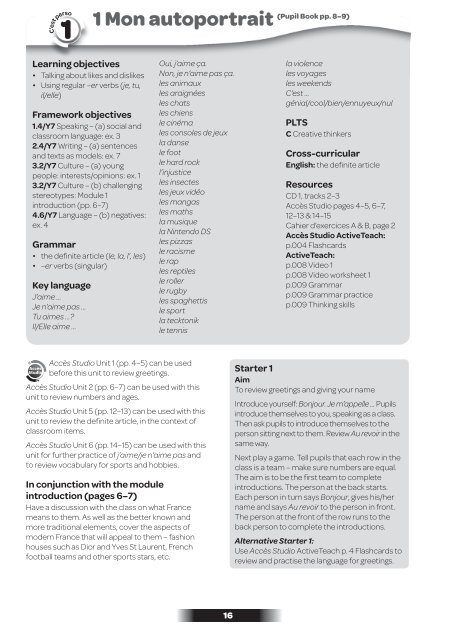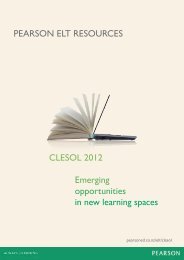Module 1: C'est perso (Pupil Book pp. 6–25) - Pearson
Module 1: C'est perso (Pupil Book pp. 6–25) - Pearson
Module 1: C'est perso (Pupil Book pp. 6–25) - Pearson
You also want an ePaper? Increase the reach of your titles
YUMPU automatically turns print PDFs into web optimized ePapers that Google loves.
Accès<br />
Studio<br />
1<br />
C’est <strong>perso</strong><br />
Learning objectives<br />
• Talking about likes and dislikes<br />
• Using regular –er verbs (je, tu,<br />
il/elle)<br />
Framework objectives<br />
1.4/Y7 Speaking – (a) social and<br />
classroom language: ex. 3<br />
2.4/Y7 Writing – (a) sentences<br />
and texts as models: ex. 7<br />
3.2/Y7 Culture – (a) young<br />
people: interests/opinions: ex. 1<br />
3.2/Y7 Culture – (b) challenging<br />
stereotypes: <strong>Module</strong> 1<br />
introduction (<strong>pp</strong>. 6–7)<br />
4.6/Y7 Language – (b) negatives:<br />
ex. 4<br />
Grammar<br />
• the defi nite article ( le, la, l’, les)<br />
• –er verbs (singular)<br />
Key language<br />
J’aime …<br />
Je n’aime pas …<br />
Tu aimes …?<br />
Il/Elle aime ...<br />
1 Mon autoportrait<br />
Accès Studio Unit 1 (<strong>pp</strong>. 4–5) can be used<br />
before this unit to review greetings.<br />
Accès Studio Unit 2 (<strong>pp</strong>. 6–7) can be used with this<br />
unit to review numbers and ages.<br />
Accès Studio Unit 5 (<strong>pp</strong>. 12–13) can be used with this<br />
unit to review the defi nite article, in the context of<br />
classroom items.<br />
Accès Studio Unit 6 (<strong>pp</strong>. 14–15) can be used with this<br />
unit for further practice of j’aime/je n’aime pas and<br />
to review vocabulary for sports and hobbies.<br />
In conjunction with the module<br />
introduction (pages 6–7)<br />
Have a discussion with the class on what France<br />
means to them. As well as the better known and<br />
more traditional elements, cover the aspects of<br />
modern France that will a<strong>pp</strong>eal to them – fashion<br />
houses such as Dior and Yves St Laurent, French<br />
football teams and other sports stars, etc.<br />
Oui, j’aime ça.<br />
Non, je n’aime pas ça.<br />
les animaux<br />
les araignées<br />
les chats<br />
les chiens<br />
le cinéma<br />
les consoles de jeux<br />
la danse<br />
le foot<br />
le hard rock<br />
l’injustice<br />
les insectes<br />
les jeux vidéo<br />
les mangas<br />
les maths<br />
la musique<br />
la Nintendo DS<br />
les pizzas<br />
le racisme<br />
le rap<br />
les reptiles<br />
le roller<br />
le rugby<br />
les spaghettis<br />
le sport<br />
la tecktonik<br />
le tennis<br />
16<br />
(<strong>Pupil</strong> <strong>Book</strong> <strong>pp</strong>. 8–9)<br />
la violence<br />
les voyages<br />
les weekends<br />
C’est …<br />
génial/cool/bien/ennuyeux/nul<br />
PLTS<br />
C Creative thinkers<br />
Cross-curricular<br />
English: the defi nite article<br />
Resources<br />
CD 1, tracks 2–3<br />
Accès Studio pages 4–5, 6–7,<br />
12–13 & 14–15<br />
Cahier d’exercices A & B, page 2<br />
Accès Studio ActiveTeach:<br />
p.004 Flashcards<br />
ActiveTeach:<br />
p.008 Video 1<br />
p.008 Video worksheet 1<br />
p.009 Grammar<br />
p.009 Grammar practice<br />
p.009 Thinking skills<br />
Starter 1<br />
Aim<br />
To review greetings and giving your name<br />
Introduce yourself: Bonjour. Je m’a<strong>pp</strong>elle … <strong>Pupil</strong>s<br />
introduce themselves to you, speaking as a class.<br />
Then ask pupils to introduce themselves to the<br />
<strong>perso</strong>n sitting next to them. Review Au revoir in the<br />
same way.<br />
Next play a game. Tell pupils that each row in the<br />
class is a team – make sure numbers are equal.<br />
The aim is to be the fi rst team to complete<br />
introductions. The <strong>perso</strong>n at the back starts.<br />
Each <strong>perso</strong>n in turn says Bonjour, gives his/her<br />
name and says Au revoir to the <strong>perso</strong>n in front.<br />
The <strong>perso</strong>n at the front of the row runs to the<br />
back <strong>perso</strong>n to complete the introductions.<br />
Alternative Starter 1:<br />
Use Accès Studio ActiveTeach p. 4 Flashcards to<br />
review and practise the language for greetings.



